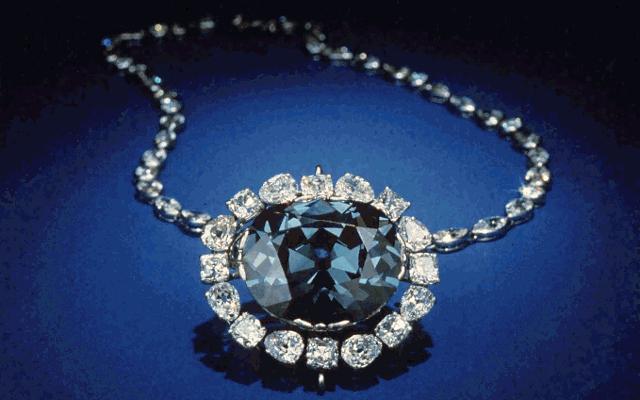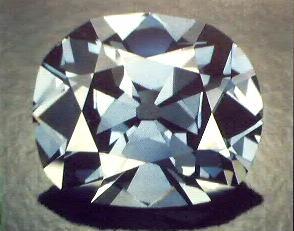
DIAMONDS

The Hope Diamond
Diamonds are the hardest substance on earth. They are more brilliant than any other natural gem. Their sparkling fire, durability, and rarity make them the most prized of gems.
The most popular diamonds are colorless. However, most diamonds have a light tint, usually yellowish or brownish. Perfectly clear diamonds are much more valuable than tinted diamonds. Very rarely, diamond occurs in deep hues of red, blue, and green. Such diamonds, known as "fancies", are extremely valuable.
Diamonds are the most lustrous of true gems. They have a brilliant luster, and also exhibit dazzling color flashes known as "fire". This is caused by dispersion, where light enters the diamond and splits into the colors of the spectrum.
Only
20 percent of mined diamonds are used in jewelry, as most are unsuitable. A
flawless diamond is exceptional; even diamonds used as gems contain flaws. A
grading system, instituted by the GIA (Gemological
Institute of America), was implemented to
evaluate diamonds based on their clarity. Three additional evaluation systems
were devised by the GIA. This leads to four attributes, known as "the four C's",
in which diamonds are evaluated:
|
Color
Cut
Clarity
Carat
weight
Color
The color of diamond is graded on an
alphabetical scale ranging from D
to Y.
This scale measures the color saturation, ranging from absolutely colorless to
deep yellow (or yellow-brown). D
is bright white -- not a hint any other color.
Y
is deep yellow or yellow-brown. The letters in-between D and Y indicate the
color, depending on the amount of yellow. The bar below depicts the letter and
the color saturation it represents. (The bar is not limited to yellow; it may
also be yellow-brown.) The letter Z
in the color grade of a diamond indicates that it is a fancy, or
deep-colored diamond.
|
|
Cut
The cut, or facet of the diamond, is the
manner in which the diamond is cut. The most preferred cut is the brilliant cut,
a facet specially designed to bring out the most "fire" in the stone. Sometimes,
this cut cannot be given, either because of flaws or cleavage habits. Other cuts
are not as valuable as the brilliant cut.
Much planning must be taken before cutting a diamond, as a slight error in the
facet may greatly decrease the value of the stone.
| Clarity Clarity is graded on the size and discernability of the flaws and inclusions. Letters are assigned to a stone to label the quality of its clarity. |
| FI |
Flawless |
Contains no flaws or inclusions at all |
| IF |
Internally Flawless |
Contains no flaws or inclusions at a magnification of 10x |
| VVS1 |
Very, very small inclusions |
Contains very tiny flaws or inclusions visible at 10x magnification |
| VVS2 |
Very, very small inclusions |
Contains tiny flaws or inclusions visible at 10x magnification |
| VS1 |
Very small inclusions |
Contains small flaws or inclusions visible at 10x magnification |
| VS2 |
Very small inclusions |
Contains flaws or inclusions visible at 10x magnification |
| SI1 |
Small inclusions |
Contains larger flaws or inclusions visible at 10x magnification |
| SI2 |
Small inclusions |
Contains larger flaws or inclusions easily visible at 10x magnification |
| I1 |
Inclusions |
Contains inclusions visible to the naked eye |
| I2 |
Inclusions |
Contains large inclusions visible to the naked eye |
| I3 |
Inclusions |
Contains very large inclusions visible to the naked eye |
Carat
Weight
The size of a diamond is measured in
carats (abbreviated as "CT"). A carat is equivalent to
0.2 grams (about 0.007 ounces).
Another weight measurement sometimes
used for small for diamonds is the point measurement
(abbreviated as "pt").
Each point is one/one hundredth of a carat. For example, a stone weighing 34 pt
weighs .34 CT.
Larger diamonds are worth more than proportionally smaller ones, meaning a 3 CT
diamond surpasses the value of three 1 CT diamonds.
USES
Diamond is the most
important gemstone in the industry. Roughly 80 percent of the gem trade is
limited to diamonds alone. Diamonds of all different colors are faceted into
various cuts; the colorless variety is most in demand. The other colors are less
commonly worn in jewelry. Deep red, green, and blue diamonds are extremely rare
and highly prized. Black, opaque diamond (bort) is occasionally faceted
into a black gemstone with a metallic luster.
Diamond is the birthstone for April.
VARIETIES
Bort
- dark colored, imperfectly crystallized, opaque diamond. May also refer to a
fragment of a gem quality diamond.
Fancy
- deep red, green, blue, or purple diamond
Canary
Diamond -
diamond with a deep yellow color

The 45.5-carat Hope Diamond as photographed when temporarily out of its setting in about 1988.
NMNH/Smithsonian collection; photo © Tino Hammid
SIMILAR GEMSTONES
Many gems resemble diamond. However, only few have a
luster and fire similar to diamond. All of those, though, are MUCH softer than
diamond. In fact, if the Mohs scale of hardness was a yard stick, and diamond was at 36", the next closet
thing to it would still only be at about 1". It is not an exactly
proportionate scale. Many synthetic materials are also made to resemble diamond, such as
YAG, strontium titanate, cubic zirconia, synthetic rutile, and synthetic spinel.
However, diamond is easily distinguished from all the others by immense
hardness. Zircon, the only natural gem that comes close in fire and luster to
diamond, is softer and has a strong double refraction.
Home
Links Spotlight
on TKPinc FAQ Gem
Information
_______________________________________________
DIAMOND QUICK FACTS

It is believed that a diamond: endows the wearer with courage and
fortitude; brings victory and good fortune; wards off evil; protects against
the plague; promotes constancy in a marriage.